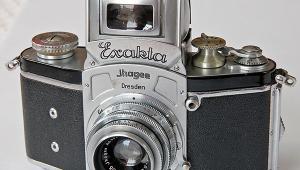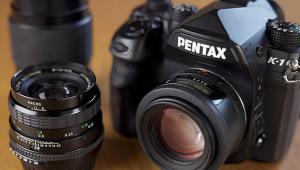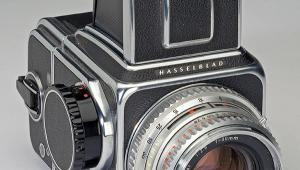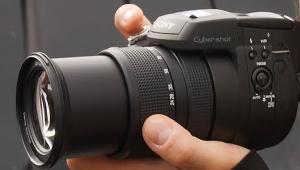Classic Cameras
Pentacon sixTL; A Classic 6x6
There's an old saying: If something appears to be too good to be true, it probably is. But sometimes you get lucky.
I couldn't resist the Pentacon sixTL that I saw in FotoSkoda in Prague. I won't say that FotoSkoda is the best camera store in the world, because there are too many other contenders, including many Shutterbug advertisers. It is, however, one of my favorites.
The Pentacon is a "giant 35mm" style like a Pentax 67, rather than a "cuboid" style like a Hasselblad or Bronica. The big 120-on-120 SLR was on offer for 3400 Czech crowns, complete with multi-coated 80mm f/2.8 CZ Jena Biometar, plus another 590 crowns for the prism. That's about $175 in all, which is less than I would expect to pay for a private sale in the U.S.A., even for a camera with a lens but without a prism. With a prism, from a dealer, with a guarantee, I'd expect to pay at least $300 for this particular model and lens.
 |
|
|
Its black lens-locking ring and the film reminders on the wind-on and shutter-speed dial reveal it as the last (and most desirable) of a family of cameras in production for 36 years from 1956-'92: first as Praktisix, then Praktisix II and IIa, then Pentacon six and Pentacon sixTL. The last came in two versions, of which mine is the later. The name of the East German manufacturer changed nearly as often. It started out as Kamera Werkstatten (KW), with prewar German roots, then mutated into VEB Kamera und Kinowerk in '59, VEB Pentacon in '64, and finally into Kombinat Pentacon VEB in '70.
Cosmetically it is in excellent condition. The only real defect was a bit of peeling leather on the bottom, easily re-fixed. The prism is nearly as good, with a small dent on one side; no damage to the glass itself. And while the lens showed slight signs of use, with brass peeking through the knurled focusing ring, the glass was perfect. Anyway, the rewind knob of my black-paint Leica MP is very nearly as worn after only 18 months of admittedly very hard use, and this camera is at least 13 years old. Besides, brass peeking through black paint is the way real cameras are supposed to look.
 |
|
|
Everything appeared to work, including the auto-diaphragm on the breech-lock 80mm f/2.8 CZ Jena Biometar multi-coated lens, so I bought it. The one thing I didn't check--and I should have--was the film counter, which didn't work at all. Unfortunately, I didn't discover this until I was back home, the best part of 1000 miles from Prague.
I should have remembered: film transport is the Achilles' heel of this camera series, though the early Praktisixes were apparently far less reliable than the later Pentacons. Problems are mostly caused by allowing the wind-on lever to fly back unrestrained after advancing the film and cocking the shutter--and it is very willing to fly back hard. You really have to train yourself to brake it with your thumb. A previous owner, presumably, hadn't.
Now, although FotoSkoda's prices are very low, their guarantee is correspondingly modest: 10 days. And it was already five days since I had bought the camera. I was nervous. No one likes working on these cameras. But no problem! The girl who answered the switchboard at FotoSkoda spoke no English, but she very quickly passed me to someone who did. He could not have been more helpful. I asked if I should return it for repair, or for a refund. "Whichever you wish," he said courteously.
 |
|
|
Before I sent it back, though, I ran a roll of outdated film through it, just to make sure there were no other problems. I was well impressed: I used Maco Ortho 100 developed for 31/2 minutes in Ilford DD-X. Under the microscope at 100x magnification, where the grain of the film was beginning to mask detail and texture, focus was spot on and central definition was excellent even at full aperture. Edge definition was not bad, and improved steadily as I stopped down.
And, of course, with a big 12-on-120 negative you don't need to enlarge very much. An A4 (210x297mm, 81/4x113/4") print with a 12mm, 1/2" border all around is rather under 5x, as compared with 7.7x off 35mm. The extra 50 percent enlargement makes a surprising difference: this is just around the point (4x to 6x) where you really start to see a difference in grain and sharpness. To be brutal, you need to be pretty sloppy not to get a first-class enlargement at 5x off 120, but you need to be pretty good to get a first-class enlargement at 7.7x off 35mm.
 |
|
|
If you prefer the digital route, even a 1200dpi optical scan (the least a modern scanner is likely to deliver) gives a handy 224mm square image (rather over 9") at the photomechanical standard resolution of 300dpi, or 336mm square (over 13") at 200dpi, widely regarded as adequate for inkjet printing. Step up to 2400dpi and you can of course double these dimensions.
- Log in or register to post comments

















































